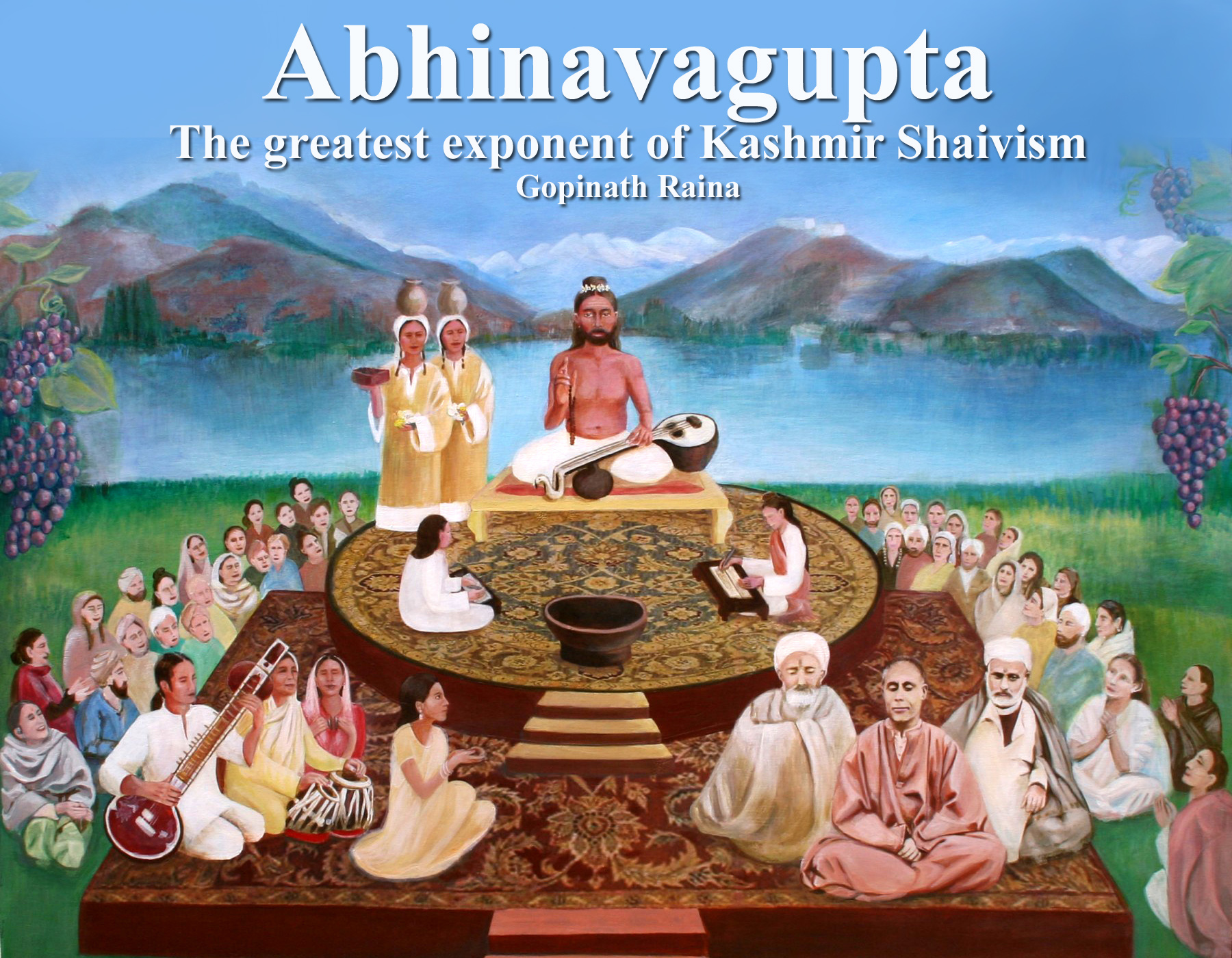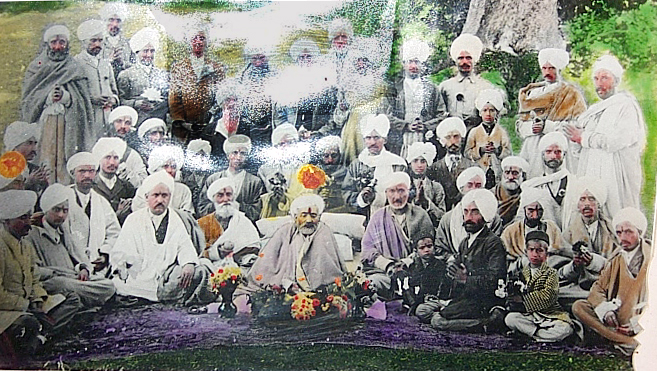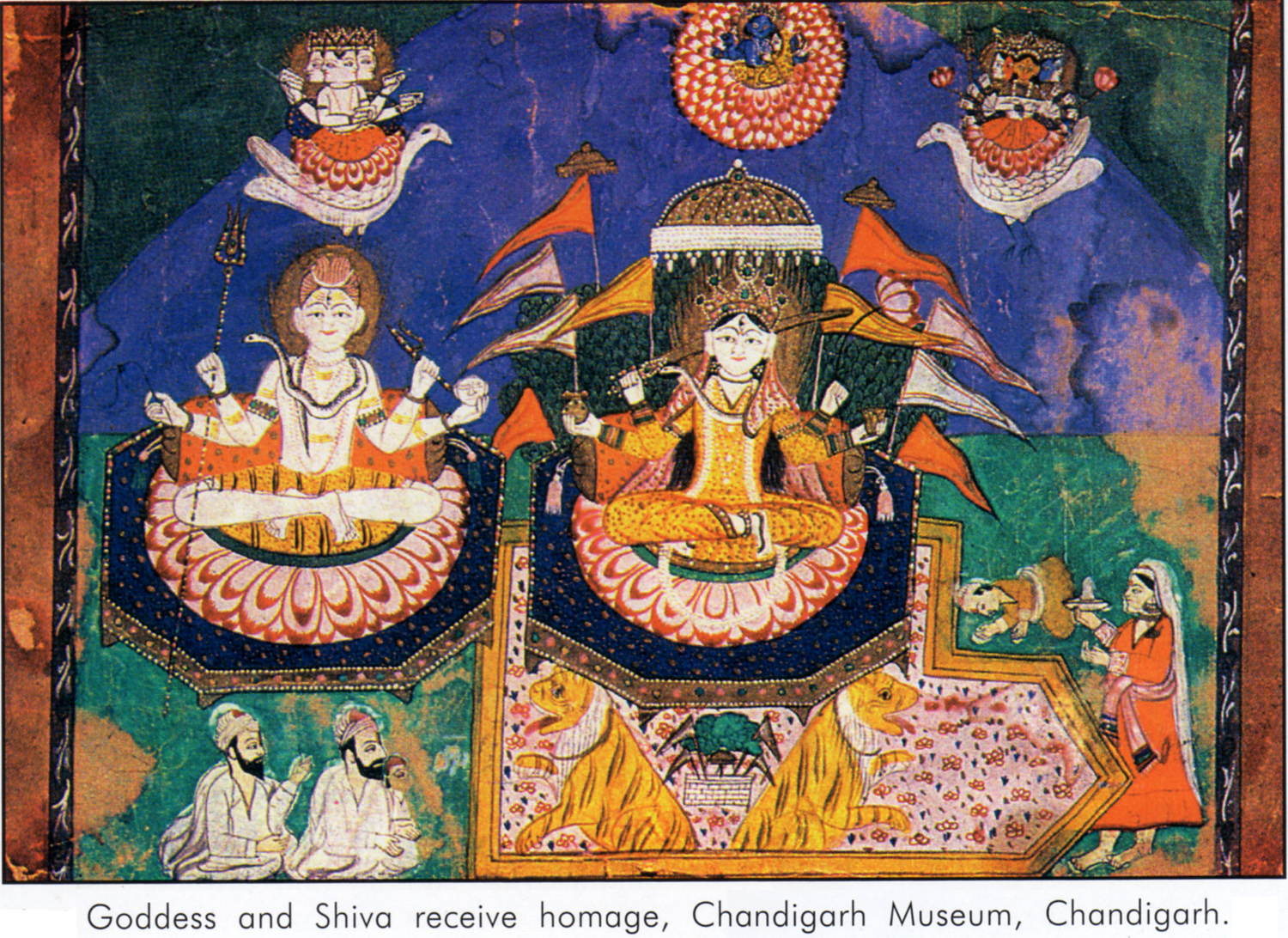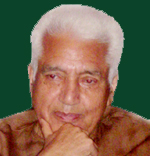Abhinavagupta The greatest exponent of Kashmir Shaivism
 |
 |
|
Spiritual
bliss is not like the intoxication of wine or that of riches, nor
similar to union with the beloved. The manifestation of the light of
consciousness is not like the ray of light from a lamp, sun or moon.
When one frees oneself from accumulated multiplicity, the state of bliss
is like that of putting down a burden; the manifestation of the Light
is like the acquiring of a lost treasure, the domain of universal
non-duality. - Abhinavagupta
India has been the land of saints and seers, sages and savants, philosophers and spiritual masters, who delved deep into the mysteries of existence and enriched humanity with the fruit of their investigation. The Vedas, the Upanishads, the epics and the Bhagvad-gita have molded the lives of millions down the ages. In ancient times, the people of Kashmir like those in the rest of India followed the religion of the Vedas. But, during the reign of Emperor Ashoka, Buddhism came to Kashmir and held its sway till the death of the great Buddhist saint-scholar, Nagarjuna (150-250 AD), when a new religious philosophy, probably a fusion of Vedic and Buddhist cultures, was evolved in Kashmir. The Beginning It is believed that Kashmir Shaivism originated near Kailasa in the Himalayas around 400 AD. Its first teacher was sage Durvasa’s disciple, Tryambakaditya, whose sixteenth descendant, Sangamaditya, settled in Kashmir around 800 AD. And it was Sangamaditya’s fourth descendant, Somananda (875-925) and his senior contemporary, Vasugupta (860-925 AD), who evolved a new system of thought in Kashmir. Both of them were not content with the prevailing creed that did not recognize either any outside scriptural authority like the Vedas or any Supreme Being called God. While Vasugupta based his philosophy on the Shiva Sutras which he found engraved on a big stone identified till this day as Shankar Pal at the eastern foot of the Mahadeva mountain, a few miles away from Harwan reservoir in Srinagar, Somananda, outlined the principles of monistic Shaiva philosophy in his famous work, Shivadrishti. These philosophical treatises on Kashmir Shaivism were later refined by a galaxy of illumined sages like Bhatta Kallata, Utpaldeva, Kshemraja and the illustrious Abhinavagupta, and in the medieval times, it was carried forward by Rajanaka Shitkanth, who was known as “Sidha Mol” (meaning perfect father). This great Shaivist is believed to have initiated the celebrated saint-poetess of Kashmir, Lalleshwari, in spirituality and mysticism. Both of them hailed from Pampore village in Kashmir Valley. In the 19th century, however, it was the great mystic, Swami Ram, who taught the lore to his avowed disciples like Swami Mahtab Kak, Swami Vidyadhar and Swami Gobind Kaul. And, it was Swami Ram’s grand-disciple, Swami Lakhsman Joo, who popularized Pratyabhijna philosophy through his writings in the 20th century.  Swami Ram with his devotees
The Final Seal
The task of putting the final seal, as it were, on the doctrine that has come to be known as Kashmir Shaivism was undertaken by none else than Abhinavagupta (950-1020 AD), an outstanding philosopher and visionary, who perfected the new system through his power of reasoning and personal spiritual attainment. The earliest ancestor of this brilliant expositor of Kashmir Shaivism was a famous Brahmin Shaiva teacher, Attrigupta who lived outside Kashmir in Autarvedi, somewhere between the Ganga and the Yamuna. It was King Lalitaditya, the ruler of Kashmir (700-736 AD), who invited Attrigupta to Kashmir for good. "Abhinavagupta" was not his real name. It was rather a title meaning "competence and authoritativeness” that he earned from one of his several masters, prominent among whom were just four:
Prolific Commentator Regarded as the greatest exegetical theologian of his time, Abhinavagupta wrote extensively on various aspects of Shaiva philosophy. He is credited with the authorship of as many as fifty works, most of them commentaries. The more famous ones are Ishvara-pratyabhijna-vivritri-vimarshini, Parmarthsara; Tantraloka and Gitartha-Sangraha. He also wrote a treatise on aesthetics,entitled Abhinavabharati that deals with dance, drama, music and poetry. Of all his works, Tantraloka (Light on the Tantras), which he wrote after he had attained enlightenment, is the monumental 12-volume encyclopedic work in verse that weaves together thoughts and ideas from a large number of authoritative scriptures. In thirty-seven chapters of this great philosophic work, he explained the process of creation and evolution of the universe in terms of the expansion of Shiva Consciousness. Abhinavagupta’s prolific writings succeeded in putting a spoke on the tidal waves of Buddhist nihilism the same way as Ramakrishna-Vivekananda axis countered the growing materialistic wave from the West in the 19th century. Trika Shastra Kashmir Shaivism is a religio-philosophical creed that deals with the three fundamentals of human existence: Man, Universe and the Ultimate Principle governing the world. Outlining the key concepts of Trika system In his book Pamarthsara, Abhinavagupta describes Consciousness of man as the Atman, the core eternal witness of all that is undergoing ceaseless change in body and mind. Since Shaivism treats Absolute Truth under the three broad principles of God, Soul and Matter, the system is known as Trika Shastra or simply Trika. It is based on the three energies of Lord Shiva, 1) Para, the subjective energy; 2) Parapara, the cognitive energy and 3) Apara, the objective energy of the Lord. It is a universal spiritual philosophy in which all aspects of life are integrated and taken in totality. The soul is said to be of the same nature as Consciousness and there is no difference either between individual soul, technically called the Pasu and the universal self called Pati, or between the world of consciousness and that of senses. 
Trika
philosophy aims at intelligent synthesis of all that is abiding and
enduring in the six systems of Indian thought. It adopted monism from
the non-dual philosophy of Vedanta, theism from the Vaishnavites, logic
from the Nyaya system, discipline from the Yoga aphorisms of Patanjali
and popular appeal from the Buddhists.
Yet, Trika system represents a positive and a theistic outlook in contrast to the absolute monism of Vedanta. Shiva is the Ultimate Reality endowed with sovereignty of will, omniscience and omnipotence. He is beyond everything. He is both immanent and transcendent. Time, form and space do not limit him, for He is above all mutation and change. Broad Classification Trika Shastra has been classified into four broad groups by Abhinavagupta: Pratyabhijna, Kaula, Krama and Spanda.
Cosmic Evolution

Philosophy of Aesthetics
Aesthetics has always played an important role in the development of various schools of Indian philosophy. We do not see God as some distant disciplinarian ruler of the universe but is thought of as an intimate and loving master. Even in ancient times Indus Valley people worshiped their deities through the medium of dance. Vedic fire altars were constructed according to aesthetic norms. Rigvedic hymns in praise of various forces of nature are aesthetically very rich. Cave paintings at Elora and Ajanta testify to the importance attached to beautiful religious images in India during the Buddhist age. Ancient temples and images at places like Khajuraho display a highly developed aesthetic sense. Music is still a central part of the spiritual practice among both the Shakta, Shaiva and Vaishnava devotees. Abhinavagupta expounded his philosophy of aesthetics in the light of his Tantric thought which postulates the existence of one Reality, the Consciousness, He did not consider aesthetics and philosophy as mutually exclusive because both lead to Supreme bliss. In art, he believed a thin and almost invisible line divides the sacred and the profane, religious and the secular. His treatise on the subject, Abhinavabharati, deals with dance, drama, poetry, music and art. His concepts and theories of rasa, bhava, aesthetics and dramaturgy have influenced succeeding generations. He tried to understand the way people respond to a work of art or a play. He said the object of any work of art is ananda (bliss). The aim of a play might be to provide pleasure. Abhinavagupta believed that aesthetics and philosophy both lead to supreme bliss. In art, aesthetic experience is ananda (bliss), akin to mystic experience, free from earthly limitations and is self luminous (svaprakasha). He makes a distinction between the world of drama and the real but ordinary life. The feeling that might cause pain in real life is capable of providing pleasure in an art form. While viewing a performance on stage, one might appreciate and enjoy the display of sorrow, separation, cruelty, violence and even the grotesque. A real work of art, in addition to possessing emotive charge, carries a strong sense of suggestion and the potential to produce various meanings. It can communicate through suggestions and evoke layers of meanings and emotions. A true connoisseur of arts knows well how to detach the work of art from its surroundings. Meticulous Divine Plan The universe with its smooth and orderly working unmistakably points to a skilled hand. The whole order of creation follows a meticulous plan and is too meaningful to be dismissed as an error. Everything has a divine purpose and every individual has a part to play. Abhinavagupta tells us that Shiva is the highest metaphysical principle, the ultimate Reality endowed with sovereignty of will omniscience and omnipotence. He is beyond everything, immanent and transcendent. Time, form and space do not limit him, for He is above all mutation and change. It is through the Instrumentality of Shakti that Shiva performs five acts of manifestation, maintenance, withdrawal, dissolution and grace. Shakti is the material as well as the efficient cause of the world. She assumes innumerable forms and is an infinite, inexhaustible storehouse of energy beyond time and space. In the boundless ocean of Shakti, countless universes float like so many bubbles. Creation and dissolution play on her lap. 
As
the symbol of eternal process of creation and destruction, Shiva
creates all that exists under the influence of desire by the mere force
of HIS WILL (Iccha Shakti). He makes the world appear in Himself
as if it were distinct from Himself, though it is not so in reality. God
is unaffected by the objects of His creation as the mirror is by the
images reflected in it.
Spiritual Path Vs Worldly Life Abhinavagupta advocated universal spiritual philosophy based on the supreme unity of the individual self with God. Accepting all the aspects of life in totality, he stressed that one’s intellectual, emotional and spiritual natures must be brought into focus to realize the goal of life. A great psychologist that he was, Abbinavagupta laid emphasis on all the three paths of Jnana (knowledge), Karma (action) and Bhakhti (devotion). In his view, these are complementary to each other and not necessarily independent means to attain full-blooded realization of the Divine. Pursuit of spiritual path, for Abhinavagupta, is not something far removed from the demands of daily life and it certainly does not mean escapism or other worldliness. The life of utter renunciation is not at all incompatible with worldly life that has its own place in the scheme of things. He refuted the idea that spiritual attainment is possible only in a purely monastic surrounding and that the householders will have to wait till the last portion of life for spiritual endeavors. Walked Into Eternity Alive A legend prevalent among Shaivists in Kashmir is that Abhinavagupta literally walked out of this mundane world alive with his 1200 disciples and entered the Bhairav cave in village Bhiruwa reciting all the while the famous Shiva hymn composed by himself--Vyaaphta Charaachar Bhaava Vishesham Chinmayam Ekam Anantam Anaadim. 
Millennium Celebrations
The millennium year celebrations of Abhinavagupta began at Vigyan Bhawan in New Delhi, India, on 13th of last month (February, 2016). Prominent personalities, including artists, litterateurs, philosophers, spiritual gurus and politicians came together to commemorate his contribution to Indian culture, religion and philosophy. Launching the celebrations, Sri Sri Ravishankar suggested that a movie must be made on the great Shaivist so that the common man is enlightened by his teachings. He appealed to the people at large to join the celebrations so that Abhinavagupta’s knowledge and teachings can reach every nook and corner of India. A book entitled “Abhinavagupta and Shiva Renaissance” by Jawaharlal Kaul was released on the occasion, which was jointly organized by Jammu Kashmir Study Centre in collaboration with the Art of Living Foundation and several other organizations. A pan-India Millennium Ceremony Committee has been formed under the Chairmanship of Sri Sri Ravi Shankar of the Art of Living Foundation to hold millennium celebrations throughout the country. Speaking on the occasion, Dr. Navjivan Rastogi, former head of Department of Sanskrit and Prakrit Languages at the Lucknow University, said Abhinavagupta was an encyclopedia himself who had studied at least 250 religious and philosophic manuscripts and Vedas and presented them in a simplified format for the common man. Relevance to Present Times Since Kashmir Shaivism adopts a humanistic approach to life, its relevance to the present times may not be over-emphasized. Its world-affirming and universal character inspires one for both material and spiritual growth. It does not advocate torture of the body or mind for it believes that once inner bliss is achieved, one will automatically give up fascination for outer worldly enjoyments. Abhinavagupta shattered to pieces the established caste and gender restrictions in relation to spiritual practices, Moving away from the obviously erroneous maya concept of Advaita Vedanta and Buddhist nihilism, it stresses positive acceptance of material world while pursuing the ultimate goal of ascending to Siva-hood. It abhors the torture of the body or mind, does not plead for suppression or forced control but lays stress on sublimation and gradual turning away from the lure of wealth, power and sense pleasures. Abiding Influence Inscriptions testify to the fact that the teachers of Pratyabhijna school of Kashmir Shaivism were held in great honor in the court of the Chola emperors, from where they diffused out all over India during the medieval period. The earliest influence of Pratyabhijna system can be seen on the post-Sankara philosophical developments in India, particularly on Ramanuja (1017-1137 AD) who propounded his philosophy of qualified monism, accepting a personal God as the Absolute. However, it was Dr. Buhler's report on the discovery of manuscripts of Shaiva Shastras of Kashmiir in 1877 that generated widespread interest in the subject, particularly after the Kashmir Research Department started intensive study of Shaiva philosophy in 1902. In recent times, Kashmir Shaivism had its votaries in the great saint-philosopher of Kerala, Sri Narayana Guru (1854-1928), the great poet-thinker, Rabindranath Tagore (1861-1941), the great mystic-Yogi, Sri Aurobindo (1872-1950), and Swami Muktananda (1908-1982). In his book entitled "The Philosophies of Sri Sankara and Sri Narayana" published in 1988, a distinguished research scholar from Kerala, Dr. B. Karunakaran, traces Narayana Guru's philosophy to the basic concepts of Pratyabhijna and says that a 'harmonious blending of Kashmir Shaivism and Advaita Vedanta can be met with in Narayana Guru's system. He points out that the influence of Abhinavgupta, rather than of Sankara, is more pronounced on Narayana Guru's perspectives. Sri Aurobindo, who gave to the world the concept of Superman, had a vivid influence of Shaivism on his thought process. Like the Shaivist thinkers of yore, he treats the world as God’s sport. He so beautifully echoes the Shaivist concept when he says: “This world was not built with the bricks of chance; a conscious power has drawn the plan of life and there is meaning in every curve and line. Individual life is not cut out of the whole and must not be viewed in isolation. The whole creation is Lord’s play (leela)”. The great poet-philosopher, Rabindranath Tagore, avers that “Kashmir Shaivism has penetrated into that living depth of thought where diverse currents of human wisdom united in a luminous synthesis.” |
|
|
 *A journalist by profession, a scholar by temperament and a writer by
choice, Gopinath Raina was inclined to study of religion from very young
age. It was Vivekananda’s dynamic exposition of Hindu thought that
fired his imagination while he was still at school. By the time he
entered college, he had been drawn to the writings of Gandhi, Aurobindo,
Narayana Guru, Radhakrishnan and Bertrand Russell.
*A journalist by profession, a scholar by temperament and a writer by
choice, Gopinath Raina was inclined to study of religion from very young
age. It was Vivekananda’s dynamic exposition of Hindu thought that
fired his imagination while he was still at school. By the time he
entered college, he had been drawn to the writings of Gandhi, Aurobindo,
Narayana Guru, Radhakrishnan and Bertrand Russell.After retiring from Indian Information Service in 1983 after completing 35 years as an editor and a correspondent in All India Radio, he edited AICC Journal, Varnika, (Jan.'84-Dec.'90), Koshur Samachar (March '91-Oct '95), Sanatana Sandesh,(1997-2005) and KASHEER (2003-2004), He has since been writing on various aspects of Hindu thought, particularly on saints and sages. Presently he lives in Miami spending his time writing personal memoirs. |
|
|
Comments
After reading the contents about
Kashmir Shaivism in this article we feel proud of our glorious past. Our
younger generation needs to be educated and involved in preserving and
propagating this rich knowledge which is answer to world
conflicts.Couple of our past generations have not taken these treasures
seriously and now one/two generations need to work on this without
wasting much time.Thanks to Sh Gopi Nath ji for educating us on the
subject/.
Added By ajay pandita
Shri Gopinath Ji has explained the
Kashmir Shaivism in a very lucid manner and in nutshell which definitely
gives an insight about our ethos & glorious past to the young minds
of our KP baradari. We should be grateful to Sh. Gopi Nath ji for
writing this beautiful article and hope he will come out more articles
on Shaivism and contributions of Achaya Abhinavgupt.
Added By Raj Kumar Tickoo
A very revealing insight into the
philosophy of Åšaiva revelation, conceived of as a descent of the
highest non-dual form of knowledge, through the different levels of
speech, into the knowledge embodied in the canon of Tantras or Agamas on
which the Åšaiva religion is based.
Added By Rakesh Kaul
The painting of Abhinavagupta at the top of this article has been used without permission. Please remove or pay due respect and mention at least the artist: Claudia Dose - claudiadose.com
ReplyDelete